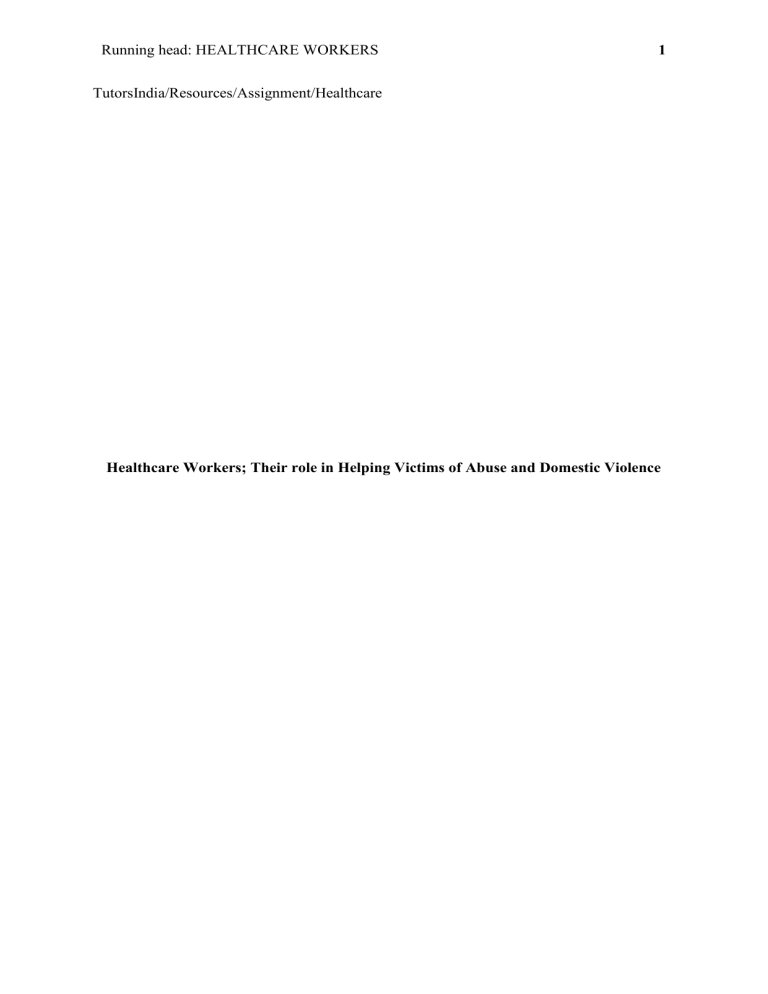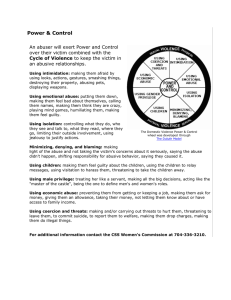
Running head: HEALTHCARE WORKERS
1
TutorsIndia/Resources/Assignment/Healthcare
Healthcare Workers; Their role in Helping Victims of Abuse and Domestic Violence
HEALTHCARE WORKERS
2
1.0 Introduction
The issue of abuse and domestic violence which is commonly termed as domestic
abuse, is considered as a problem that impacts women as well as men. This would be
irrespective of their caste, financial status, ethnic origin, educational qualifications or sexual
orientations [1]. Domestic abuse has been defined in several ways and many terms have been
utilized to describe it. Across several developed nations there are terms such as; spousal
violence, intimate partner violence or family abuse that have been used commonly. Such
terms are extensively used to widely elucidate the kind of violence or abuse which might
occur within people in the age group of 18 or above and is generally distinct from sexual
abuse and violence or child abuse [2]. The impact from domestic abuse is known to affect all
facets in the life of the victim such as; social, mental, economic and financial [3]. In addition,
individuals who are exposed to domestic violence have more scope to experience issues in
health, have the propensity to miss work and thus suffer loss of income which impacts the
nation as well. As per evidence presented by the, it is said that around 1.9 million people in
the UK, aged between 16 – 59 years, experience domestic abuse. Between men and women,
women are more prone to experience domestic abuse. The rate of prevalence of domestic
abuse has been estimated as 6 out of every 100 adults, at the rate of 4.3% men and 7.5%
women, thus leading to 713000 men and 1.2 million women [4].
HEALTHCARE WORKERS
3
Figure 1: Percentage of Adults (16-74years) who Experienced Domestic Abuse in 2020
Source: Nick Stripe [4]
It has been clearly stated by Public health guideline [5] that professionals from the
domain of healthcare have a responsibility to extend support to individuals who have been
impacted by domestic abuse. Nonetheless, prevalent evidence has indicated that the focus of
social workers is mostly on issues pertaining to child protection and children, while tending
to ignore adult victims of abuse. Evidence presented by Robbins and Cook, [1] also indicated
that those individuals who have experienced domestic abuse and have interacted with social
workers’ state that social workers were not very helpful in terms of facilitating the required
support. Therefore, this paper would explore the role of social workers in providing care to
victims of domestic abuse. The roles would mainly be; victim identification, referring to
specialist domestic violence services and extending legal assistance.
HEALTHCARE WORKERS
4
2.0 Role of Social Workers
2.1 Victim Identification
As far as healthcare professionals are concerned, victim identification is quite
significant. Though the evidence in this context is mixed in terms of the need for routine
screening for identifying domestic abuse victims, it has been empirically proven that
healthcare professionals are required to do more for victim identification [6]. Considering
that social workers have more probability of being in touch with individuals who are in such
abusive situations, there is scope that would improve identification of an abuse victim.
Appropriate response is a major aspect of victim identification in situations where individuals
might reveal the abuse they are experiencing [7]. Considering that concerns have risen about
distrust of social workers in extending to adult victims of domestic abuse, social workers are
expected to be rather empathetic while responding to victims and their families in instances
of abuse. This would go a long way in developing trust.
[Looking to write a master dissertation on Healthcare ? Get in touch with us
info@tutorsindia.com]
2.2 Referring to Specialist Services
A significant role that social workers are supposed to play would be to refer domestic
abuse victims to specialist services. Though social workers are not expected to have the
expertise to provide the required specialist support, they should be in a position to refer
victims to the right specialist. Most victims fail to approach specialist service providing
agencies owing to several agencies [8] but when victims are referred to specialist services by
social workers, it becomes easy for the victims to consider the referral. Some common
barriers faced by victims include; fear of repercussion, stigma, shame, disbelief and fear of
HEALTHCARE WORKERS
5
being blamed [9]. Therefore, due academic assistance from social workers would enable
victims to get the required help.
2.3 Legal Assistance
Modifications effected recently within legislation has indicated that social workers
play a major role in extending support to individuals who have been exposed to violence or
victims of domestic abuse. As per the Legal Aid, Sentencing and Punishment of Offenders
Act, the level of evidence which can be permitted to provide support for matter relating to
domestic abuse. Though it has been specified in the Act that documentary evidence could be
provided by healthcare workers to facilitate legal assistance, there was no clarity on
documentary evidence that social workers could provide [10]. Nonetheless, changes effected
in the law in the UK[law academic writing help] has revealed that social workers have been
acknowledged as individuals who can clearly identify as well as refer victims of domestic
abuse thereby, extending documentary proof thus allowing victims to gain legal assistance.
3.0 Conclusion
The issue of domestic abuse is no doubt a private problem which tends to have huge
impact on public health as well as well-being of individuals and the nation. It leads to the
creation of major problems in health which makes an impact on the economy of the nation,
the ability of the abused individual to study and work and also to the healthcare system on the
whole. This essay explored the role of social workers and healthcare professionals in
extending support to victims of domestic abuse.
HEALTHCARE WORKERS
6
References
[1]
R. Robbins and K. Cook, “‘Don’t Even Get Us Started on Social Workers’: Domestic
Violence, Social Work and Trust—An Anecdote from Research,” Br. J. Soc. Work,
vol. 48, no. 6, pp. 1664–1681, Sep. 2018, doi: 10.1093/bjsw/bcx125.
[2]
Z. Rakovec-Felser, “Domestic violence and abuse in intimate relationship from public
health perspective,” Heal. Psychol. Res., vol. 2, no. 3, Oct. 2014, doi:
10.4081/hpr.2014.1821.
[3]
O. Femi-Ajao, S. Kendal, and K. Lovell, “A qualitative systematic review of published
work on disclosure and help-seeking for domestic violence and abuse among women
from ethnic minority populations in the UK,” Ethn. Health, vol. 25, no. 5, pp. 732–
746, Jul. 2020, doi: 10.1080/13557858.2018.1447652.
[4]
Nick Stripe, “Domestic abuse prevalence and trends, England and Wales: year ending
March 2020,” 2020.
https://www.ons.gov.uk/peoplepopulationandcommunity/crimeandjustice/articles/dom
esticabuseprevalenceandtrendsenglandandwales/yearendingmarch2020.
[5]
Public health guideline, “Domestic violence and abuse: multi-agency working,” 2014.
https://www.nice.org.uk/guidance/ph50.
[6]
L. J. O’Doherty, A. Taft, K. Hegarty, J. Ramsay, L. L. Davidson, and G. Feder,
“Screening women for intimate partner violence in healthcare settings: abridged
Cochrane systematic review and meta-analysis,” BMJ, vol. 348, no. may12 1, pp.
g2913–g2913, May 2014, doi: 10.1136/bmj.g2913.
[7]
L. J. Bacchus, A. M. Buller, G. Ferrari, P. Brzank, and G. Feder, “‘It’s Always Good
HEALTHCARE WORKERS
7
to Ask’: A Mixed Methods Study on the Perceived Role of Sexual Health Practitioners
Asking Gay and Bisexual Men About Experiences of Domestic Violence and Abuse,”
J. Mix. Methods Res., vol. 12, no. 2, pp. 221–243, Apr. 2018, doi:
10.1177/1558689816651808.
[8]
A. Malpass, K. Sales, M. Johnson, A. Howell, R. Agnew-Davies, and G. Feder,
“Women’s experiences of referral to a domestic violence advocate in UK primary care
settings: a service-user collaborative study,” Br. J. Gen. Pract., vol. 64, no. 620, pp.
e151–e158, Mar. 2014, doi: 10.3399/bjgp14X677527.
[9]
D. Spencer, A. Dodge, R. Ricciardelli, and D. Ballucci, “‘I Think It’s Re-Victimizing
Victims Almost Every Time’: Police Perceptions of Criminal Justice Responses to
Sexual Violence,” Crit. Criminol., vol. 26, no. 2, pp. 189–209, Jun. 2018, doi:
10.1007/s10612-018-9390-2.
[10] Owen Bowcott and Alexandra Topping, “Domestic abuse victims with ‘trapped
capital’ should not be denied legal aid, court rules,” 2020.
https://www.theguardian.com/society/2020/nov/25/domestic-abuse-victims-withtrapped-capital-should-not-be-denied-legal-aid-court-rules (accessed Nov. 01, 2020).





